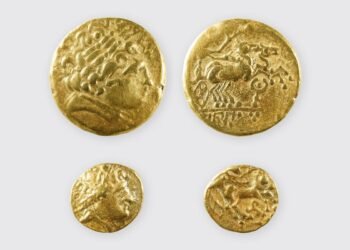A team of archaeologists from the PUCP Archaeology Program “Valley of Pachacámac” have uncovered 73 intact burial bundles with carved masks, dating back to the Wari Empire.

Credit: PUCP Archaeology Program “Valley of Pachacámac”, CC BY-SA 4.0
The discovery was made at the archaeological site of Pachacámac, southeast of Lima, Peru. The Pachacámac site, named after the creator god Pacha Kamaq, was first settled around CE 200 by the Wari, a Middle Horizon civilization.
Recent excavations, as reported on the Archeowieści blog managed by the Faculty of Archaeology of the University of Warsaw, revealed these burial bundles at the foot of the Painted Temple, a significant structure within the archaeological complex.
The burial bundles, also known as ‘fardos,’ offer valuable information about the Wari burial customs during the second half of the Middle Horizon (CE 800–1100). Some of the bundles were found deposited individually, while others were grouped together.

Notably, several individuals within the burial bundles were adorned with carved masks, referred to as “false heads,” made of carved wood and ceramics—a common burial practice among the Wari culture.
Professor Krzysztof Makowski from the Pontifical Catholic University of Peru, emphasized the cultural significance of the discovery, stating, “In the pre-Hispanic Andes, no one died; everyone was predestined to continue living in the parallel world of their ancestors.” The excavations also unearthed wooden staffs adorned with images of Wari elite wearing Tiwanaku-type headgear, found in a votive deposit covered with oyster shell fragments imported from Ecuador.
Contrary to prior beliefs about Pachacámac’s history, the discovery challenges the notion that the site was a continuous sacred city from the construction of the Old Temple until the Spanish arrival. The findings indicate that during the Wari Empire period, Pachacámac functioned differently, resembling a settlement with a ceremonial platform rather than an elite necropolis.

The burial bundles are considered a goldmine of information, offering insights into the social positions of men, women, and children based on kinship ties, as well as evidence of war, domestic violence, and care for the invalid. Nineteen bundles will undergo laboratory tests, including CT scans, allowing researchers to analyze their contents without opening them.
This discovery challenges previous assumptions about Pachacámac’s role in Wari culture. It also suggests connections between Pachacámac and the Tiwanaku kingdom, highlighting ancient trade routes and cultural exchanges.


























